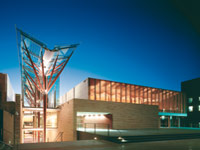|
|||||||||||||||||||||||||||||||||||||||||
| Biomedical Engineering - 8660 | |||||||||||||||||||||||||||||||||||||||||
The MBiomedE degree program is designed to cater for students with either a medical/biological science or engineering/physical science background.
In the early part of the program, students with a medical/biological science background are expected to study basic engineering subjects such as mathematics, mechanics, electronics and computing, whilst students without a biomedical background should take courses in physiology, anatomy, pathology or biochemistry. All candidates then choose electives from the core biomedical engineering electives and may also undertake an optional 12 unit if credit research project(Masters Thesis).This project may be conducted either at the UNSW or in a hospital or other external organization. The course of study offers scope for original research into the application of engineering principles and technology to medical problems. Period of candidature: The normal period is three academic sessions (full-time) or six academic sessions (part-time) from the date of enrolment. The maximum period of candidature is six academic sessions (full-time) and twelve academic sessions (part-time). In special cases extensions may be granted. Program Objectives and Learning Outcomes Please contact the Graduate School of Biomedical Engineering for information regarding the Program Objectives and Learning Outcomes.
The program offers some flexibility in the early stages whereby students from different backgrounds may undertake introductory courses to broaden their knowledge of either biomedical or physical sciences. Candidates must complete a program totaling 72 units of credit, 48 of which must be for the study of subjects at graduate level. A minimum of 48 units must be from subjects offered by the Graduate School of Biomedical Engineering (ie. any courses with BIOM9 prefix). A candidate is not permitted to continue in the program if they fail in more than 18 units of credit.
The core biomedical engineering content may be selected from the following options: Session 1
Session 2
Notes:
Please refer to Program Structure and contact your school office for the Academic Requirements relating to this program.
For information regarding fees for UNSW programs, please refer to the following website: https://my.unsw.edu.au/student/fees/FeesMainPage.html
Area(s) of Specialisation |
|||||||||||||||||||||||||||||||||||||||||



